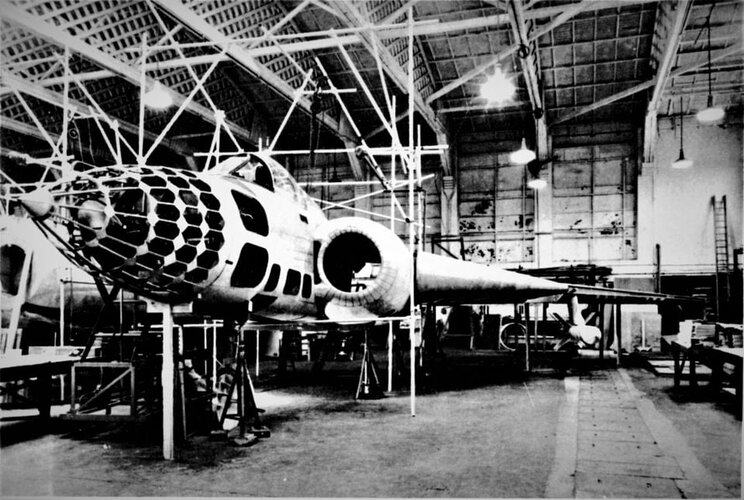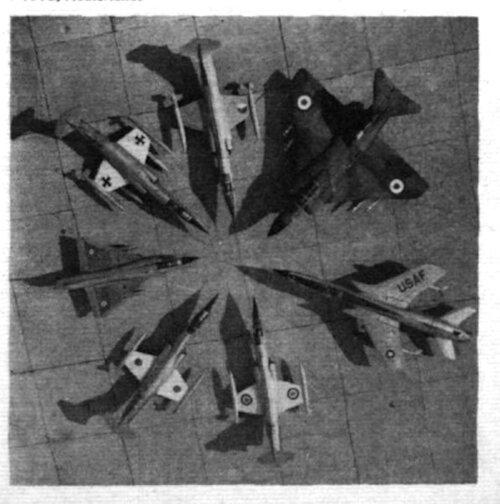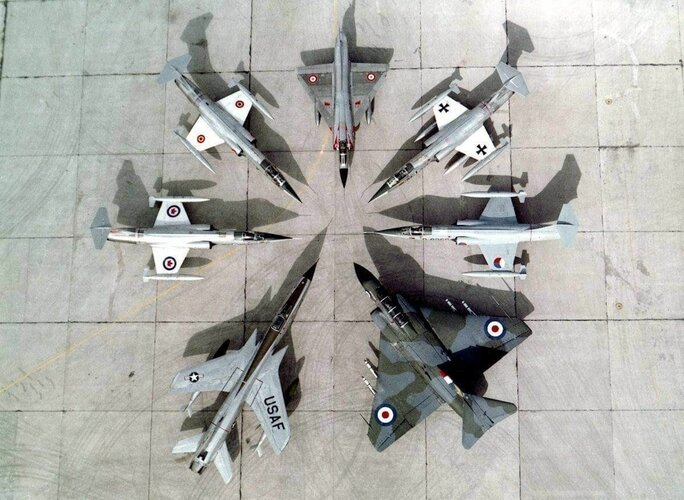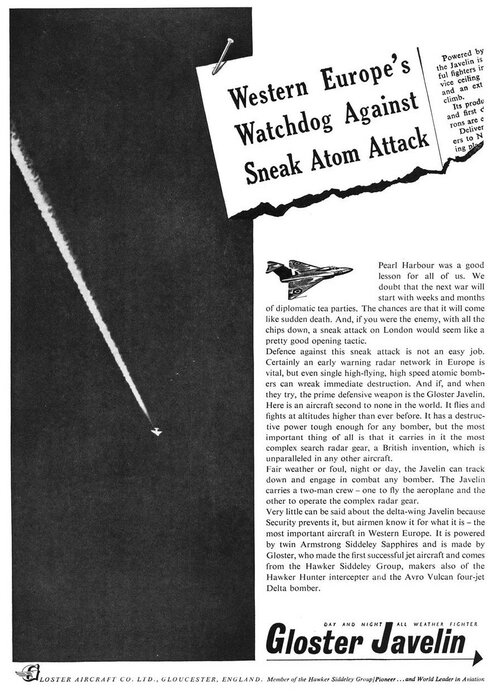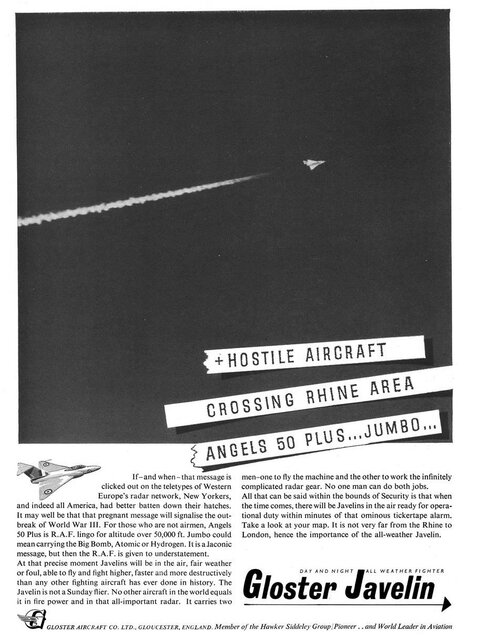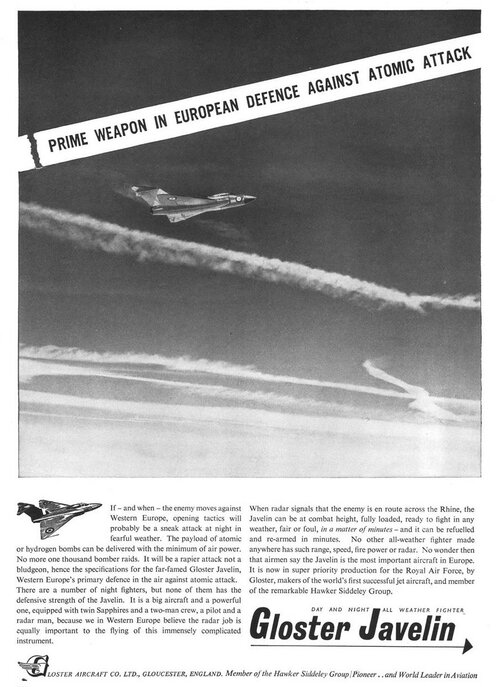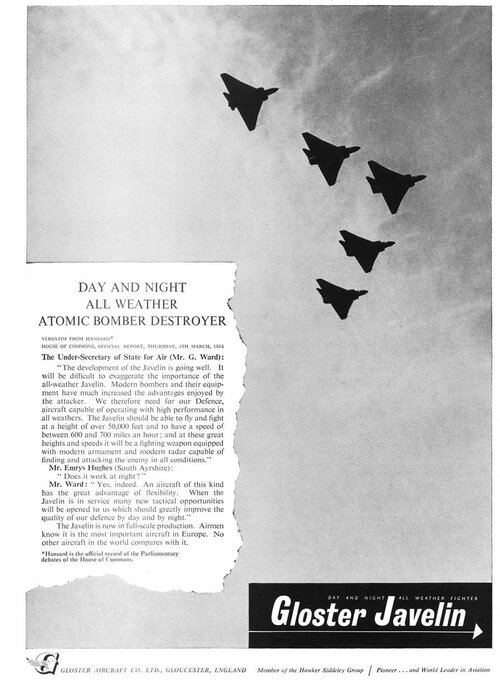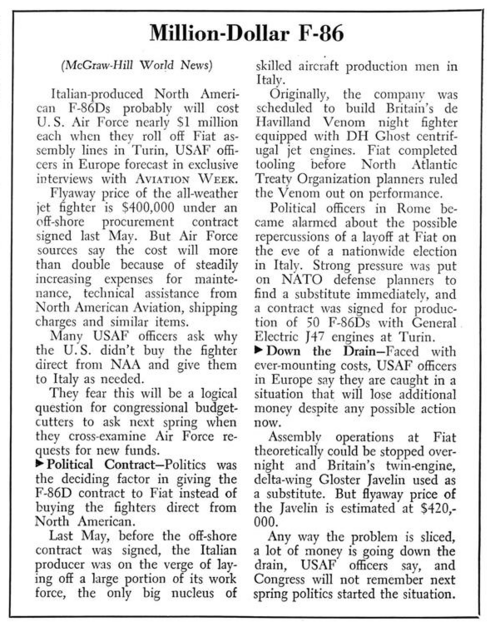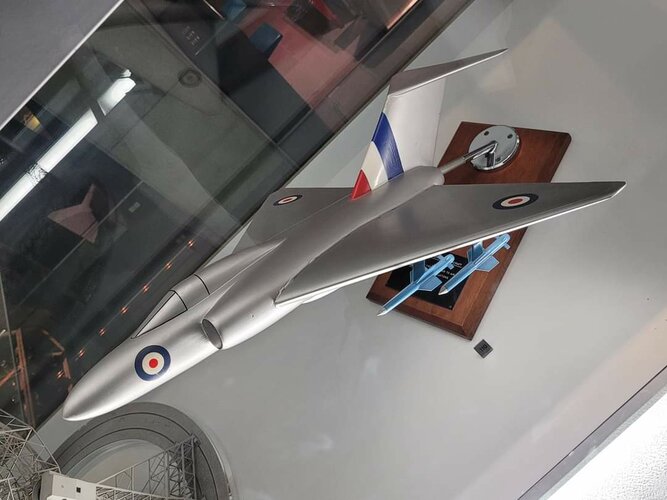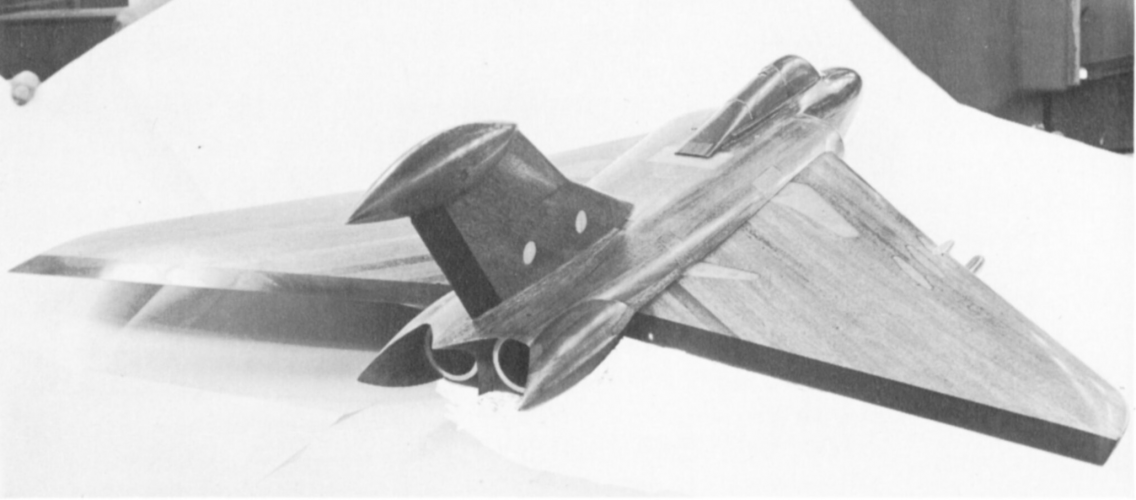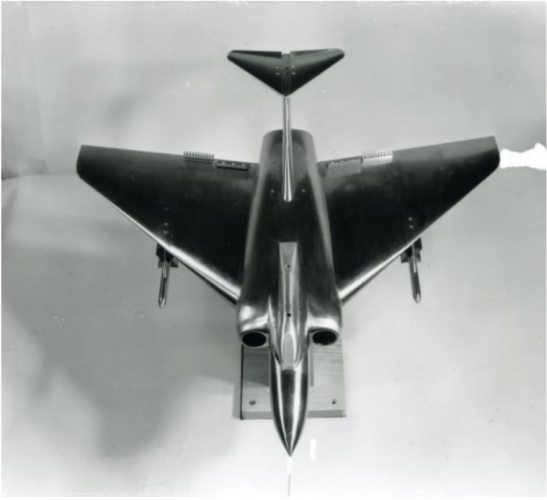I may have asked this elsewhere but does anyone know of any Naval carrier based proposals related to the Javelin?
You are using an out of date browser. It may not display this or other websites correctly.
You should upgrade or use an alternative browser.
You should upgrade or use an alternative browser.
Gloster Javelin Projects
- Thread starter Barrington Bond
- Start date
pathology_doc
ACCESS: Top Secret
- Joined
- 6 June 2008
- Messages
- 1,587
- Reaction score
- 1,507
I can add more if people are interested.
Hell, yeah.
In fact, I think it would be fair to say that we would happily accept PDF uploads of your entire personal collection (whether this is feasible or desirable is another matter, of course, and your choice... but a man may dream, may he not?
You've given us a tantalizing glimpse at the factors which might have cost the project its existence, although there's a part of me which says "A faster Javelin is surely a better Javelin, given that the subsonic version lasted till 1968. Surely better, for all its flaws, to ditch that and build this instead?"
shedofdread
ACCESS: Top Secret
- Joined
- 14 November 2009
- Messages
- 593
- Reaction score
- 398
acegeek9992
ACCESS: Confidential
- Joined
- 25 March 2021
- Messages
- 111
- Reaction score
- 77
Dang. Looks like visibility's going to be a total crapshot on this one!The May 2009 issue of Aviation News included an article I had written about some proposed variants of the Gloster Javelin. One of the projects was the P.293 and I'm afraid the drawing was missed. Therefore, please find it attached. Hope you like it!
Best Wishes to all.
Tony.
Kiltonge
Greetings Earthling
- Joined
- 24 January 2013
- Messages
- 632
- Reaction score
- 1,181
Found when looking for something else, 1964 overhead shot showing the surprising size of the Javelin. Makes a Thunderchief look average.
Wing areas, square metres:
Wing areas, square metres:
| F-104 | 18.2 |
| Mirage III | 34.85 |
| F-105 | 35.76 |
| Javelin | 86.1 |
| Canberra ( for reference ) | 97.1 |
Attachments
Last edited:
F.L.
ACCESS: Top Secret
Kiltonge
Greetings Earthling
- Joined
- 24 January 2013
- Messages
- 632
- Reaction score
- 1,181
So much drag. Yet, internal fuel was 1,140 US Gallons in the Javelin and 1,180 in the Thud...
In July 1954 the flyaway cost of a Javelin under offshore procurement was between $360,000 and $420,000 versus $590,000 for a FIAT-built F-86K. The escalating cost of the Italian-built Sabres, which rose to nearly $1 million once spares, shipping and assistance from NA was included, led to consideration of swapping FIAT to building the Javelin instead. They had originally tooled-up for production of the Venom until a last-minute change to the Sabre.
For comparison, other offshore procurement costs:
| Type | Program cost | Units | Unit cost |
| Hunter, UK | $140 million | 465 | $207,000 |
| Sea Hawk, UK | $12.8 million | 107 | $119,720 |
| Mystere IV, France | $86.5 million | 225 | $280,000 |
| Hunter, Netherlands | $18 million | 48 | $234,206 |
| Hunter, Belgium | $24 million | 64 | $234,206 |
Last edited:
- Joined
- 21 May 2006
- Messages
- 3,002
- Reaction score
- 2,270
Nice find RAPDrawing of the F.153D. I have not seen this before. It is from RAF Fying Review April 1962. Hope this is the right place for this.
Updated with pictures of the wind tunnel model. I think you are right Paul about the missing tailplanes.
As seemingly the trend of the era for the Britain/RAF, that seems a lot of aeroplane for just two missiles, especially when one considers the reliability of early AAM's
Regards
Pioneer
Kiltonge
Greetings Earthling
- Joined
- 24 January 2013
- Messages
- 632
- Reaction score
- 1,181
More about the nearly-Italian-Javelins.
Fabrique Nationale, Fokker and FIAT were all jostling to build the Javelin under Mutual Security Agency funding as the NATO-standard night-fighter. Around March 1953 FIAT were selected as preferred manufacturer, largely on grounds of maintaining an aeronautical workforce in Italy, for an initial $25 million contract.
Brig Gen Al Boyd and Lt Col Dick Johnson flew the Javelin in February / March and it appears to have passed technical assessment.
However the contract was changed to the F-86D in April 1953 as Gloster could not establish the FIAT production line until 1956, a year later than the F-86D. North American received a royalty of $5,500 on each FIAT-built Sabre.
However the British kept heckling for a second, subsidised, production line for the Javelin. Their argument was that the FIAT Sabre production contract was inadequate to meet NATO needs. Through early 1955 Gloster ran advertising for the Javelin in the US press, but despite the unit cost FIAT continued to build the Sabre, additionally supplying France, Netherlands and Norway.
Fabrique Nationale, Fokker and FIAT were all jostling to build the Javelin under Mutual Security Agency funding as the NATO-standard night-fighter. Around March 1953 FIAT were selected as preferred manufacturer, largely on grounds of maintaining an aeronautical workforce in Italy, for an initial $25 million contract.
Brig Gen Al Boyd and Lt Col Dick Johnson flew the Javelin in February / March and it appears to have passed technical assessment.
However the contract was changed to the F-86D in April 1953 as Gloster could not establish the FIAT production line until 1956, a year later than the F-86D. North American received a royalty of $5,500 on each FIAT-built Sabre.
However the British kept heckling for a second, subsidised, production line for the Javelin. Their argument was that the FIAT Sabre production contract was inadequate to meet NATO needs. Through early 1955 Gloster ran advertising for the Javelin in the US press, but despite the unit cost FIAT continued to build the Sabre, additionally supplying France, Netherlands and Norway.
Attachments
Last edited:
More about the nearly-Italian-Javelins.
How is it possible that the single engine and much smaller F-86K is much more expensive than a Javelin?
Kiltonge
Greetings Earthling
- Joined
- 24 January 2013
- Messages
- 632
- Reaction score
- 1,181
How is it possible that the single engine and much smaller F-86K is much more expensive than a Javelin?
I don't have a conclusive answer though I found this report in AvWeek, Nov 1953, suggesting that shipping components to Italy was part of the cause. It was also the first US design built under the offshore system so there was probably a steep learning curve.
Bear in mind as well the UK had benefited from $112 million of machine tooling from the USA for both airframe and engine manufacture, and UK aero-production was ( perhaps surprisingly ) rated as very efficient by the USA. Neither of these advantages applied to FIAT...
At $420k a unit, less than twice that of a Hunter, the Javelin does seem to have been quite a bargain for the N/AW capability it provided.
Attachments
BLACK_MAMBA
ACCESS: Secret
- Joined
- 17 July 2019
- Messages
- 382
- Reaction score
- 877
Rocket Javelin
https://www.linkedin.com/pulse/rock..._medium=member_android&utm_campaign=share_via
Investigation into the drag reduction of TW P.376 Javelin. Interestingly, at subsonic speeds it was not much better if at all due to increased base drag...
https://www.linkedin.com/pulse/rock..._medium=member_android&utm_campaign=share_via
Investigation into the drag reduction of TW P.376 Javelin. Interestingly, at subsonic speeds it was not much better if at all due to increased base drag...
Last edited by a moderator:
Rocket Javelin
https://www.linkedin.com/pulse/rocket-javelin-steve-liddle-ceng-fraes?utm_source=share&utm_medium=member_android&utm_campaign=share_via
Investigation into the drag reduction of TW P.376 Javelin. Interestingly, at subsonic speeds it was not much better if at all due to increased base drag...
Does this link work?
Last edited:
link edited, should be working now
Excellent article.
pathology_doc
ACCESS: Top Secret
- Joined
- 6 June 2008
- Messages
- 1,587
- Reaction score
- 1,507
The Tony Buttler article that this article links to in turn is very interesting, because it shows (on its 9th page, p.94 of the publication as a whole) a silhouette superposition of the Fairey Delta 2 on the Delta 3. Because we already know* that the FD.2 is very nearly the same size (in length, wing area and span) as the Mirage III, it offers a useful bit of context into how big the Delta 3 actually would have been.
* from the Project Cancelled superposition image of Mirage III and FD.2
* from the Project Cancelled superposition image of Mirage III and FD.2
- Joined
- 25 January 2020
- Messages
- 1,279
- Reaction score
- 1,948
Hi all,
I was reading through the section about the Thin Wing javelin in Tony Buttler's BSP 1, and I'm rather confused as to the project timeline. There were various studies which were all under the "Thin Wing Javelin" title, from the P.356 to the GA.8 Guardian, but all are quite different to each other, and some seemed to be ordered and begin construction.
My main question is, how many projects were actually laid down? From what I understand the P.356 was ordered, but I'm not sure if it began construction, as by the time the project was cancelled, it was the P.376 that was being built. The way I understood it is that the P.356 was ordered and laid down, but the design was changed, eventually leading to the P.376. I discussed this with some fellow researchers elsewhere, but I'm not sure if this assumption is correct, and I would like some second opinions on this issue.
I would like to hear your thoughts, your patience and understanding is also greatly appreciated. Unfortunately, I'm not very familiar with the developmental history of the Javelin.
Jason
I was reading through the section about the Thin Wing javelin in Tony Buttler's BSP 1, and I'm rather confused as to the project timeline. There were various studies which were all under the "Thin Wing Javelin" title, from the P.356 to the GA.8 Guardian, but all are quite different to each other, and some seemed to be ordered and begin construction.
My main question is, how many projects were actually laid down? From what I understand the P.356 was ordered, but I'm not sure if it began construction, as by the time the project was cancelled, it was the P.376 that was being built. The way I understood it is that the P.356 was ordered and laid down, but the design was changed, eventually leading to the P.376. I discussed this with some fellow researchers elsewhere, but I'm not sure if this assumption is correct, and I would like some second opinions on this issue.
I would like to hear your thoughts, your patience and understanding is also greatly appreciated. Unfortunately, I'm not very familiar with the developmental history of the Javelin.
Jason
- Joined
- 27 May 2008
- Messages
- 1,178
- Reaction score
- 2,482
Ref https://www.secretprojects.co.uk/threads/gloster-javelin-projects.3938/#post-328189
From the drawings and photos of the components on GAC Bentham shop floor I believe what was being built was the P371. This was a “rationalised” P356.
What causes a lot of confusion is the mock ups, of which there were at least four of different P3xx varieties.
From the drawings and photos of the components on GAC Bentham shop floor I believe what was being built was the P371. This was a “rationalised” P356.
What causes a lot of confusion is the mock ups, of which there were at least four of different P3xx varieties.
- Joined
- 25 January 2020
- Messages
- 1,279
- Reaction score
- 1,948
Yeah it's quite confusing. It doesn't help that the original order was placed for the P.356, which is why I asked this, as I had thought that the P.356 began construction first.Ref https://www.secretprojects.co.uk/threads/gloster-javelin-projects.3938/#post-328189
From the drawings and photos of the components on GAC Bentham shop floor I believe what was being built was the P371. This was a “rationalised” P356.
What causes a lot of confusion is the mock ups, of which there were at least four of different P3xx varieties.
- Joined
- 27 May 2008
- Messages
- 1,178
- Reaction score
- 2,482
The key exterior difference between the P356 and P370 is the forward position of the air intake. On the P356 it’s level with the front pilot canopy hoop whereas on the P370 it’s level with just in front of the pilot rear bulkhead.
The Gloster Aircraft Company drawing in my post 36 of this thread (the transport section break down, dated well after contact award) clearly shows the P370 in take position. This is also supported by some of the cockpit sections photo I have of the as built components.
The P356 was Sapphire SA 7 powered whereas P370 was Oly SR7 powered. The Oly needed more air hence requiring a re jig of the intake geometry.
The original brochure was for the P356 in May 53. By the beginning of 54 the decision was taken to use the Oly. The P370 configuration emerged in about Sep 54. This was taken to contract in Jan 55. The project was known within GAC as the “GA6” with the GA5 being the Javelin. Nearly all the original documents I have/seen call it the GA6 and those that don’t call it 153D.
The P376 was a very different aircraft structure due the adoption of area ruling and highly raked intakes. This concept didn’t emerge until Feb 56 and wasn’t fully architected until mid 56 by which time it was all over. The guys I spoke to who worked on GA6 said virtually nothing from P370 was useable. Upon cancellation there was a disbelief which meant the design iterations just kept coming for a while (including a whole new mock up of the P376) with increasing desperation. The P376 probably came about when Gloster’s got wind of just how uncompetitive P370 was compared to Arrow;- the RAF evaluation team paid a visit to Canada in Jan 56.
If you have any period documents I would love to see them even if you didn’t want to publish it. Pm me please.
Ps the P370/1/2 were the same airframe configuration but with different equipment fit.
The Gloster Aircraft Company drawing in my post 36 of this thread (the transport section break down, dated well after contact award) clearly shows the P370 in take position. This is also supported by some of the cockpit sections photo I have of the as built components.
The P356 was Sapphire SA 7 powered whereas P370 was Oly SR7 powered. The Oly needed more air hence requiring a re jig of the intake geometry.
The original brochure was for the P356 in May 53. By the beginning of 54 the decision was taken to use the Oly. The P370 configuration emerged in about Sep 54. This was taken to contract in Jan 55. The project was known within GAC as the “GA6” with the GA5 being the Javelin. Nearly all the original documents I have/seen call it the GA6 and those that don’t call it 153D.
The P376 was a very different aircraft structure due the adoption of area ruling and highly raked intakes. This concept didn’t emerge until Feb 56 and wasn’t fully architected until mid 56 by which time it was all over. The guys I spoke to who worked on GA6 said virtually nothing from P370 was useable. Upon cancellation there was a disbelief which meant the design iterations just kept coming for a while (including a whole new mock up of the P376) with increasing desperation. The P376 probably came about when Gloster’s got wind of just how uncompetitive P370 was compared to Arrow;- the RAF evaluation team paid a visit to Canada in Jan 56.
If you have any period documents I would love to see them even if you didn’t want to publish it. Pm me please.
Ps the P370/1/2 were the same airframe configuration but with different equipment fit.
Last edited:
Kiltonge
Greetings Earthling
- Joined
- 24 January 2013
- Messages
- 632
- Reaction score
- 1,181
I have a technical question. Were Javelins used overseas still equipped with the Gee Mk 3 navigation or was this nav system replaced with something else, like the Rebecca Mk 8 or simply with an ADF or VOR?
I can't answer your question specifically but Rebecca was standard fit from the FAW.8 onwards.
- Joined
- 25 January 2020
- Messages
- 1,279
- Reaction score
- 1,948
Unfortunately I don't have access to period documents, as I live outside of the UK. I am looking into seeing if I can get documents scanned, but I don't know if it's viable at the moment. My assumptions are based off of Tony Buttler's BSP 1 (the latest edition) for the most part. Unfortunately, it doesn't help that I'm unfamiliar with the Javelin's developmental history, as it's something I've only started to look into with some detail in the last few weeks.If you have any period documents I would love to see them even if you didn’t want to publish it. Pm me please.
The book makes mention of an order for the P.356 by the RAF, however, I'm uncertain if it was ever laid down as a P.356, as, given the evidence laid out in this thread, it seems that by the time construction started, the aircraft may have already become the P.371. Unfortunately my lack of access to primary sources is inhibiting progress in my research, and my friends who are helping me have also drawn a blank in regards to sourcing. I'll have a look round and see if there are any books or scholarly articles which may help in the short term, but my current position prevents me from having access to primary sources at present.
- Joined
- 25 January 2020
- Messages
- 1,279
- Reaction score
- 1,948
Is there any information regarding the flight trials of the "Kuchemann Carrots", and what effects would they have on performance?From The Aeroplane 14 November 1958.
Not something i have come across as yet, were there any formal pitches to sell the Javelin overseas (im wondering if this may have been discouraged due to MDAP. funding of the type ?)
On a side note there are photographs of ex RAF,. aircraft in Singapore AF. markings left behind for use as instructional airframes.
On a side note there are photographs of ex RAF,. aircraft in Singapore AF. markings left behind for use as instructional airframes.
Last edited:
Kiltonge
Greetings Earthling
- Joined
- 24 January 2013
- Messages
- 632
- Reaction score
- 1,181
Not something i have come across as yet, were there any formal pitches to sell the Javelin overseas (im wondering if this may have been discouraged due to MDAP. funding of the type ?)
Other than nearly being selected as the NATO std all-weather fighter, Belgium is the only other nation that comes to mind. They evaluated the Jav in October 1954, sending two pilots and a radar engineer.
- Joined
- 26 May 2006
- Messages
- 34,869
- Reaction score
- 15,733
Drawing of the F.153D. I have not seen this before. It is from RAF Fying Review April 1962. Hope this is the right place for this.
Updated with pictures of the wind tunnel model. I think you are right Paul about the missing tailplanes.
A clearer views.

Top 10 Cancelled British Fighters
From the dawn of the aeroplane until the 1960s, Britain produced world-class fighter aircraft. As well as the designs that actually felt the air beneath their wings, there is a tantalising treasury…
Attachments
Similar threads
-
-
-
Zimmerman STOVL Aircraft Designs of 1958
- Started by hesham
- Replies: 0
-
Question about Gloster unmanned helicopter ?
- Started by hesham
- Replies: 6
-

